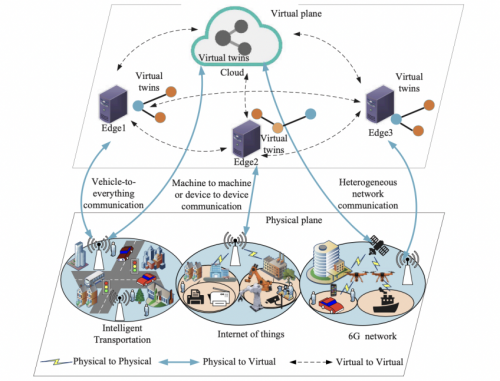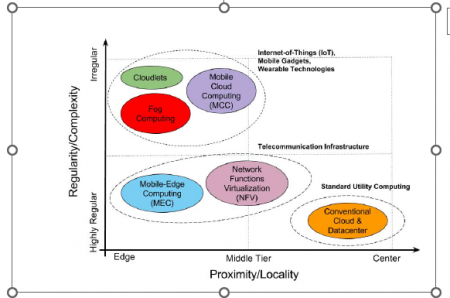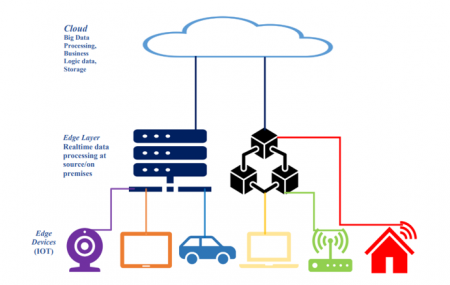Introduction to Edge Computing
Introduction to Edge Computing
Edge computing was developed to address the challenges of cloud computing, such as slow response times, security risks, and the overwhelming data traffic caused by the increasing number of internet-connected smart devices. By processing data closer to its source instead of relying on distant cloud servers, edge computing ensures faster and more efficient performance.

With the rise of the Internet of Things (IoT) in the early 2000s, experts predicted that by 2019, a significant share of IoT data would be processed at the edge rather than in centralized cloud data centers. This shift was driven by the need for rapid responses in applications like self-driving cars and smart cities, where even minor delays could have serious consequences. Unlike traditional cloud computing, edge computing enhances security, reduces latency, and processes data locally, relieving pressure on the internet while improving overall efficiency. As technology continues to evolve, edge computing plays a crucial role in enabling faster, safer, and more reliable digital experiences.
1.1 What is Edge Computing?
1.2 Why we need Edge Computing?
The Need for Edge Computing
The exponential growth of data generated by IoT devices, autonomous systems, and real-time applications has placed significant strain on traditional cloud computing architectures. Edge computing emerges as a solution to process data closer to its source, reducing latency, improving efficiency, and enhancing security. This paper explores the necessity of edge computing by analyzing its benefits, key applications, and challenges.

1.2.1 Latency Reduction and Real-Time Processing
One of the primary drivers for edge computing is the need for real-time data processing. Applications such as autonomous vehicles, healthcare monitoring, and industrial automation require immediate responses, which centralized cloud computing fails to provide due to network latency. By processing data at the edge, delays are minimized, ensuring faster decision-making.
1.2.2 Bandwidth Optimization
With billions of IoT devices transmitting data, traditional cloud systems face bottlenecks in network bandwidth. Edge computing mitigates this by processing essential data locally and only sending relevant insights to the cloud, reducing overall bandwidth consumption.
1.2.3 Enhanced Security and Privacy
Data transmitted over the cloud is susceptible to breaches. Edge computing reduces exposure by keeping sensitive data closer to the source, thereby lowering the risk of cyberthreats. This is particularly important in healthcare and financial sectors, where data privacy is crucial.
===1.2.4=== Scalability and Cost Efficiency Deploying edge computing reduces infrastructure costs by minimizing the need for high-bandwidth connectivity and extensive cloud storage. Additionally, edge nodes can be deployed dynamically based on application needs, offering a scalable solution.
2. Applications of Edge Computing
2.1 Smart Cities and IoT
Edge computing enables real-time traffic management, smart surveillance, and energy-efficient city planning by processing data locally, reducing dependency on centralized cloud infrastructure.
2.2 Healthcare and Remote Patient Monitoring
Wearable devices and remote patient monitoring systems generate vast amounts of data. Edge computing ensures quick processing for timely medical interventions while maintaining data privacy.
2.3 Industrial Automation and Manufacturing
Industries leveraging automation benefit from edge computing through predictive maintenance, real-time quality control, and enhanced operational efficiency.
2.4 Autonomous Vehicles
Self-driving cars require immediate data processing to make split-second decisions. Edge computing allows vehicles to process sensor data locally, ensuring safety and reliability.
Benefits
While edge computing offers numerous advantages, it also presents challenges such as: • Infrastructure Complexity: Managing distributed edge nodes requires sophisticated coordination and maintenance. • Security Vulnerabilities: Edge devices, if not properly secured, can become points of failure. • Interoperability Issues: Different vendors and technologies may create integration challenges. • Power and Resource Constraints: Edge devices must balance performance with power consumption.
Edge computing is essential for modern digital ecosystems, enabling real-time processing, bandwidth efficiency, security enhancements, and cost-effective scalability. As industries increasingly adopt edge technologies, addressing its challenges will be crucial to maximizing its potential.

1.3 Edge Computing application Domains and Typical Applications
Edge computing processes data closer to the source, reducing latency, bandwidth usage, and reliance on cloud computing. This approach is transforming various industries by enabling real-time analytics, automation, and enhanced decision-making. Below is a detailed explanation of each domain and how edge computing is applied within them.
1.3.2 Autonomous Vehicles & Transportation
The transportation sector requires real-time data processing for safety, efficiency, and automation. Autonomous vehicles, smart traffic systems, and connected infrastructure rely on low-latency computing to function effectively.
1.3.2 Industrial IoT (IIoT) & Manufacturing
Factories and industrial plants increasingly integrate IoT devices for automation, quality control, and predictive maintenance. These operations require real-time decision-making to minimize downtime and optimize efficiency.
1.3.3 Energy & Smart Grids
The energy sector is undergoing a digital transformation, integrating smart grids, renewable energy sources, and real-time energy management solutions. These systems must process large volumes of data efficiently.
1.3.4 Smart Cities & Infrastructure
Smart cities integrate edge computing for efficient urban management, security, and environmental monitoring. Data is processed locally to reduce network congestion and response times.
1.3.5 Telecommunications & 5G Networks
Telecommunications providers leverage edge computing to improve network performance, reduce latency, and optimize bandwidth usage. 5G networks particularly benefit from distributed processing at the edge.
1.3.6 Healthcare
Healthcare systems generate massive amounts of data from medical devices, imaging systems, and patient monitoring. Real-time processing is critical for quick diagnosis, treatment, and remote patient care.
1.4 Different Edge Computing Paradigms
References
- “ Edge Computing: Vision and Challenges” - IEEE Internet of Things Journal
- "An Overview on Edge Computing Research"
- "A Survey on Edge Computing for the Internet of Things" – ACM Computing Surveys.